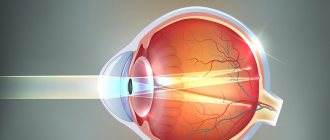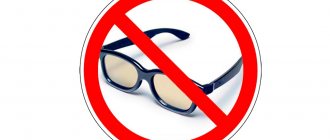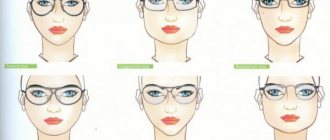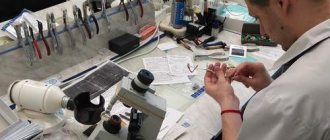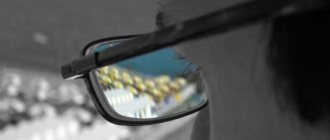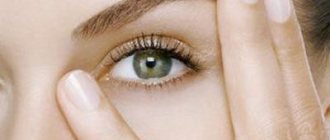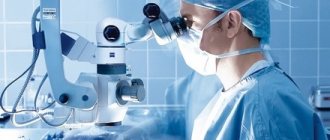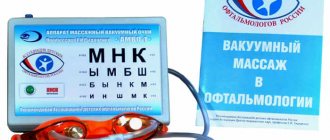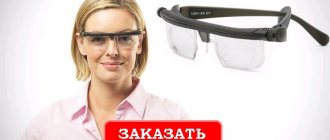Pankov glasses are a portable device intended for quantum restoration and iridoreflexotherapy, as well as preventive measures to prevent diseases of the eyes and internal organs. The device was created by prof. O.P. Pankov for use in clinics, outpatients and at home. Its purpose is rehabilitation and prevention of eye diseases.
“Pankov glasses” can be recommended for people whose work activities involve visual stress (office workers and researchers, teachers, programmers, pilots, drivers, writers, etc.).
The device will be useful for elderly people with age-related changes in vision: cataracts, glaucoma, retinal angiopathy (including that that develops against the background of hypertension or diabetes) and children whose eyes are vulnerable due to the growth process.
Specifications
The device is a spectacle frame in which 2 LED emitters are mounted, controlled by built-in microprocessor controllers located directly in the emitters. The emitters are combined with a power supply. The radiation wavelength is 450, 530 and 650 nm. The radiation mode is pulse-periodic. Power supply – 4 button batteries (AG-13). Power consumption - up to 0.1W. Device weight – 200g.
The device is supplied with the following configuration:
- Pankov Glasses apparatus.
- Technical data sheet, instructions.
- Packing box.
Pankov glasses (Rainbow of Insight device)
Intended for use both at home (does not require special training) and in ophthalmology departments of hospitals and clinics.
Before starting operation, you must study and follow all the rules and recommendations given in the manual. The device is intended for carrying out physiotherapeutic procedures for the treatment and prevention of diseases of the visual organs according to the method of Professor Oleg Pavlovich Pankov, in outpatient settings in ophthalmology departments of clinics, as well as individual use at home in accordance with medical techniques and the attached instructions.
Diseases of the visual organs for which the Device can be used:
- myopia (nearsightedness)
- hypermetropia (farsightedness)
- cataract
- glaucoma
- astigmatism
- amblyopia
- retinal dystrophy
- optic atrophy
- strabismus
- computer vision syndrome (CVS)
The device can be used for:
- normalization of eye pressure,
- improvement of intraocular hemo- and hydrodynamics
- relieving spasm of accommodation
- improving lymphatic drainage and the functional state of the retina and optic nerve
- stimulating the development of binocular vision
- improving the functional state of the retina and optic nerve.
The principle of operation of the Device is based on the interaction of optical radiation of the visible part of the spectrum with biological tissue. The restorative effect of the Device is based on a cascade of photochemical reactions in the retina and eye tissues, activating the vascular and lymphatic systems of the eye and internal organs. The device is manufactured in the UHL climatic version according to category 4.2. GOST R 15150. Power is supplied from a built-in safety extra-low voltage power supply in accordance with GOST R 50267.0. The device is intended for use in enclosed spaces at ambient temperatures from +10°C to +40°C, with relative air humidity up to 80% and atmospheric pressure 650 ±80 mmHg Based on the possible consequences of product failure, the device belongs to class 1 according to GOST R 51609.
Technical characteristics: The device meets the requirements of TU 9444-001-78551706-2006. Emission wavelengths range from 430 to 470 nm (blue emission), 520 to 540 nm (green emission), and 620 to 660 nm (red emission). The radiation power in the output plane of the Device is from 0.05 to 0.3 mW. The radiation mode is pulse-periodic. The outer surfaces of the Device are resistant to disinfection with a 3% hydrogen peroxide solution in accordance with GOST 177 with the addition of 0.5% detergent in accordance with GOST 25644 or a 3% chloramine solution in accordance with TU 6-01-4689387-16-89.
Delivery set: LED ophthalmological device, professor O.P. Pankova “Rainbow of Epiphany” 1 piece; technical passport 1 piece; packing box 1pc.
Design and operation of the Device The device is structurally a portable device, in the form of glasses, in the frame of which three-color LEDs are mounted, one for each eye. Each LED contains three semiconductor crystals that emit light in the visible part of the spectrum (R;G;B) at different wavelengths. Also, each LED has one microchip built into it that controls the operation of the LED crystals. Sources of quantum radiation provide restoration processes of the organs of vision with low-intensity radiation in the visible region of the spectrum in the wavelength range 430-660 Nm, with a maximum radiation at these wavelengths. The frame of the glasses is connected by a flexible electrical wire to the plastic housing of the device's power supply. The power supply box is a plastic box, inside of which there is a power switch, metal contact plates and springs. Also inside the power supply are two AA batteries (R06).
Contraindications Absolute contraindications: inflammatory eye diseases in the acute and acute stages; acute period after transplantation; chronic mental illness; age less than 3 years; oncological diseases of the eyes and central nervous system; infectious eye diseases. Relative contraindications: in case of acute eye diseases, it is necessary to consult with your doctor or consultant; hypotension; macular degeneration of the retina (sessions should be carried out only as prescribed by the attending physician); severe forms of diabetes mellitus (decompensation); concomitant pulmonary tuberculosis; acute period of myocardial infarction; stroke; for tumors of different localization (light therapy should be carried out only under the supervision of an oncologist or attending physician); pregnancy (light therapy should be carried out after consultation with your doctor). The device is registered as a medical device and approved for use throughout Russia by RosZdravNadzor of the Russian Federation. , Moscow city.
The device is used according to the method of Professor O.P. Pankov and is produced with the consent of the legal heirs (sons), Professor Oleg Pavlovich Pankov. Permission dated November 15, 2013. License for the production of medical equipment No. FS-99-04-002144 dated December 8, 2014. Registration certificate No. FSR 2008/03904 dated 10/22/2013.
You can always buy Pankov Glasses (Rainbow Epiphany device) in our online store. You can place your order through the Cart, fill out the 1-Click quick order form, or call our phone numbers.
Operating principle of the device
Pulses of light, affecting the eyes, can have a unique healing effect. They cause the pupils to constrict and dilate at a reflex level, due to which the spasm of accommodation disappears, and the strength of the accommodative muscle (responsible for focusing images on the retina) increases. The rhythmic contraction of the eye muscles caused by the device influences the blood circulation, activates lymphatic drainage, improves microcirculation in the retina, as well as in other tissues of the eye, which improves their nutrition, activates the mechanisms of neural transmission - visual perception.
“Pankov glasses” are capable of changing the diameter of the pupil, as well as the position of the iris, which helps the intraocular fluid to better move along the outflow pathways into the anterior chamber, where it is enriched with nutrients. Thanks to this, the nutrition of the anterior segment of the eye with the cornea, iris and lens improves. That is why the device is prescribed for use in diseases of these eye structures.
The method of influencing the eyes with Professor Pankov’s quantum glasses
The essence of the innovative method for restoring visual acuity is to influence the retina with quantum radiation of different shades. For this reason, the device is also called the “Rainbow of Insight”.
The human eye is designed in such a way that it is able to distinguish shades only after impulses from the brain reach certain nerve endings. If the visual apparatus is quickly exposed to rays of different colors, all tissues and nerve endings are excited, the blood circulation process is activated and areas that were previously “lazy” to do their job “come to life.”
The device is successfully used in many ophthalmology clinics; patients leave only positive feedback about it. According to experts, color therapy is an ideal option for people who lose visual acuity and spend a lot of time in front of a computer monitor.
In other words, the “Rainbow of Insight” is a simulator that improves the physiological functions of all “elements” of the ocular apparatus.
Indications for use
- asthenopia;
- initial cataract;
- amblyopia, astigmatism;
- glaucoma;
- myopia, farsightedness (including age-related);
- optic nerve atrophy;
- strabismus;
- computer syndrome;
- retinal dystrophy;
- postoperative period.
Where can I buy an innovative exercise machine?
The exercise machine should not be purchased from online stores, since there is a high risk of running into a fake. From the TV screen and on the World Wide Web there are many advertisements about this unique invention. But everywhere the focus is not on its training purpose, but on its healing properties.
There are a lot of advertisements about sales of low-quality devices on the websites of big cities. Almost everyone who purchased glasses via the Internet was dissatisfied with the product, which caused a wave of negative criticism of the device and doubts about its effectiveness.
Mode of application
Treatment sessions are carried out in a position convenient for the patient. Before they begin, breathing exercises are performed (literally several rhythmic inhalations and exhalations).
The therapeutic effect should not be carried out while watching TV or immediately before bed, as well as at the time of irritation and in a state of increased nervousness.
The exposure time to the device is up to 15 minutes per session, 1 session per day is recommended.
The first session begins with a 3-minute exposure. At the beginning of the session, the patient's eyes are closed, this is necessary for a gradual subsequent increase in the intensity of the effect. Sessions are lengthened over and over again by 3 minutes, until a maximum duration of 15 minutes is reached. The full course is 15 sessions. The interval between courses is 1 month.
For tired eye syndrome, short sessions (3 minutes) can be done as needed, before and then after work that causes eye strain.
The best result of treatment with the device will be achieved with simultaneous use of it and taking vitamins for the eyes (Anthocyan Forte, Lutein Complex), as well as topical use of drops (Quinax, Taufon, etc.).
You should not take a break between sessions for more than three days.
Pankov glasses: instructions for use
Sessions using a unique simulator are carried out in a sitting or lying position. Before starting the procedure, the patient is recommended to perform simple gymnastics, inhale and exhale deeply several times.
You should not use glasses while watching television or before going to bed. The procedure is also not recommended if the person is agitated or irritated. The duration of the patient's exposure to light diodes is fifteen minutes. To complete the full course you will have to visit the doctor at least 15 times. The break between therapies should be at least thirty days.
During the first minutes of the session, keep your eyes closed so that the doctor can gradually increase the intensity of the light beam. For the first time, the maximum duration of exposure is three minutes, increase it little by little, adding a few minutes to the original time every day.
For chronic eye fatigue, the simulator is used one hundred and eighty seconds before the start of “tiring” work and the same amount after its completion.
Doctors recommend taking a comprehensive approach to combating the problem and, along with the device, taking a course of vitamins (Vitrum Vision, Lutein Complex, etc.), using special eye drops, such as Taufon, Emoxipin.
Contraindications
- pregnancy;
- inflammatory diseases in the acute phase;
- period after transplantation;
- tumor processes of the head;
- macular degeneration of the retina;
- age up to three years;
- chronic mental disorders;
- diabetes mellitus in the stage of decompensation;
- hypotension;
- stroke.
Possible contraindications for using an innovative vision simulator
"Rainbow Prosveta" is not suitable for all patients. There are a number of prohibitions on using the device:
- Pregnant and lactating women;
- Children under three years old;
- After undergoing surgery to install an implant;
- Inflammation of the visual organ;
- Liver or kidney failure;
- Use of a pacemaker;
- Problems with blood clotting;
- Thyroid pathologies;
- Brain oncology;
- Malignant and benign tumors of the visual apparatus;
- Diabetes;
- Low blood pressure;
- Mental disorders.
GLASSES – spectacle correction of vision
GLASSES are, without a doubt, the most widespread method of vision correction on the planet. According to WHO, about 30% of the world's population has poor vision, and the vast majority of them use glasses for correction. In some countries, such as Japan, the majority of adults use glasses. This is explained by the fact that writing based on hieroglyphs quickly spoils vision, leading to myopia. The merit of the points is beyond doubt. Hundreds of millions of people are able to see normally with the help of glasses. But for all its merits, spectacle vision correction has its drawbacks. Is there an alternative to glasses? What can modern ophthalmology offer instead of spectacle vision correction?
GLASSES - ADVANTAGES OF spectacles vision correction
- GLASSES AVAILABLE
— prices for glasses are affordable, you can buy glasses for 50 rubles (at a market stall) and for hundreds of dollars (if these glasses are also a precious handmade accessory). But buying the RIGHT glasses is not so easy. Glasses for vision correction should be selected ONLY by a specialist, after a comprehensive vision examination in a specialized office or clinic. You should buy glasses ONLY in specialized optical stores, paying special attention to the quality of the lenses.
- GLASSES ARE SIMPLE TO USE
– this is true, glasses are quite easy to put on.
- THERE IS OFTEN NO ALTERNATIVE TO GLASSES
– There is simply no alternative to glasses for vision correction in childhood. Laser correction operations are performed only after the eye has fully matured, starting at the age of 18. The use of contact lenses in children is highly limited. However, you must always remember that incorrectly selected glasses can cause further deterioration of vision, especially in childhood.
GLASSES - DISADVANTAGES OF spectacles vision correction
- GLASSES ARE INCOMPLETE VISION CORRECTION
— glasses are selected in such a way that they do not provide 100% vision correction. Glasses significantly limit lateral vision, disrupt the stereoscopic effect and spatial perception. These factors are especially important for vehicle drivers.
- GLASSES ARE A FOREIGN OBJECT ON THE FACE
– with all their advantages, glasses can cause a lot of inconvenience to their owner - they constantly get dirty, fog up, slip and fall, and interfere with sports and any other vigorous physical activity.
- GLASSES - RISK OF INJURY
- glasses, especially with glass lenses, are dangerous. In the event of an accident or fall, broken glass lenses can cause serious injury.
- GLASSES CAN HURT YOUR FEELING OF WELL-BEING
– Incorrectly selected glasses lenses lead to chronic eye fatigue. An incorrectly selected frame can cause circulatory problems in the face. As a result, headaches, fatigue and impaired performance occur.
- GLASSES – THE CAUSE OF FURTHER VISUAL DECREASE
- incorrectly selected glasses can cause constant eye fatigue and contribute to the progression of eye diseases such as myopia, astigmatism, farsightedness, etc.
GLASSES - AN ALTERNATIVE TO spectacles vision correction
Currently, modern ophthalmology can offer only two generally accepted alternatives to glasses:
CONTACT VISION CORRECTION
- using contact lenses
EXCIMER LASER CORRECTION
— surgeries using PRK and LASIK technology
Each of the alternatives has its own advantages and limitations. The final choice must be made by the patient himself. The basic rule is that to make the right choice you need to know everything about the state of your vision - any type of vision correction requires consultation and assistance from a specialist.
WHERE TO CHOOSE GLASSES RIGHT?

